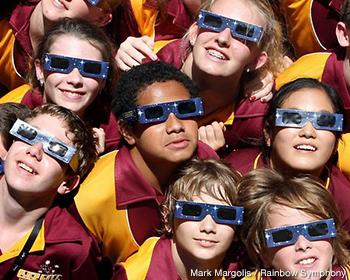
As noted in How to View a Solar Eclipse Safely, looking directly at the Sun is unsafe except during the brief total phase of a solar eclipse (“totality”), when the Moon entirely blocks the Sun’s bright face, which will happen only within the narrow path of totality. To find out whether your home or any other specific location is within the path of totality on April 8, 2024, see Xavier Jubier's Google Map, which supports zooming in to street level.
The only safe way to look directly at the uneclipsed, partially eclipsed, or annularly eclipsed Sun is through special-purpose solar filters, such as “eclipse glasses” or handheld solar viewers. Homemade filters or ordinary sunglasses, even very dark ones, are not safe for looking at the Sun (fact: special-purpose solar filters are at least 1,000 times darker than ordinary sunglasses). See our Suppliers of Safe Solar Filters & Viewers page for a list of sources of eclipse glasses and handheld solar viewers verified to meet the ISO 12312-2 international standard for such products. Also see our companion article, "How Can You Tell If Your Eclipse Glasses or Handheld Solar Viewers Are Safe?"
Instructions for safe use of solar filters/viewers (see also How to View a Solar Eclipse Safely):
- Always inspect your solar filter before use; if scratched, punctured, torn, or otherwise damaged, discard it. Read and follow any instructions printed on or packaged with the filter.
- Always supervise children using solar filters.
- If you normally wear eyeglasses, keep them on. Put your eclipse glasses on over them, or hold your handheld viewer in front of them.
- Stand still and cover your eyes with your eclipse glasses or solar viewer before looking up at the bright Sun. After looking at the Sun, turn away and remove your filter — do not remove it while looking at the Sun.
- Do not look at the uneclipsed, partially eclipsed, or annularly eclipsed Sun through an unfiltered camera, telescope, binoculars, or other optical device.
- Similarly, do not look at the Sun through a camera, a telescope, binoculars, or any other optical device while using your eclipse glasses or handheld solar viewer — the concentrated solar rays could damage the filter and enter your eye(s), causing serious injury.
- Seek expert advice from an astronomer before using a solar filter with a camera, telescope, binoculars, or any other optical device; note that solar filters must be attached to the front of any telescope, binoculars, camera lens, or other optics.
- If you are inside the path of totality for a total solar eclipse, remove your solar filter only when the Moon completely covers the Sun’s bright face and it suddenly gets quite dark. Experience totality, then, as soon as the bright Sun begins to reappear, replace your solar viewer to look at the remaining partial phases. Note that there is no time during a partial or annular solar eclipse when you can safely view the Sun directly without eye protection.
- Outside the path of totality for a total solar eclipse, you must always use a safe solar filter to view the Sun directly.
Suppliers of Safe Solar Filters & Viewers
 More information about eclipse eye safety:
More information about eclipse eye safety:
- 1-Page Eclipse Safety Flyers in English & Spanish
- Detailed Technical Report on Solar Eclipse Eye Safety
- Suppliers of Safe Solar Filters & Viewers
- About the ISO 12312-2 Standard for Solar Viewers
- Eyewear & Handheld Viewers
- Projection: Pinhole & Optical
- Solar Filters for Optics: Telescopes, Binoculars & Cameras

